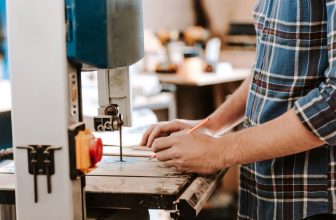Contents
Wondering how to use a jigsaw? That’s a question that’s puzzled many new tool owners over the years. Well, we are pleased to say they are just as simple as they look as long as you keep safety mind.
If you’re new to the woodworking world or just need this type of tool for a particular task, we will guide you along. Our experts have covered all the important areas for beginners, and we’ve thrown in a few tips for experienced craftsman as well.
What can you use a Jigsaw for?
Jigsaws can make quick cuts with precision or allow you to cut a variety of shapes on the fly.
Wood and even plaster are no match for a jigsaw, and metal can be cut with ease as well. While they can cut a straight line, it’s not what they were made to do. Their main selling point is its ability to cut curves. Angled cuts are a breeze, and we feel it’s a great beginner’s tool if you are just getting started in the shop.
How to use a Jigsaw
What do you plan to cut?
Are you working with regular wood and need to cut a curve or is it a more substantial material like metal? Before you fire up your jigsaw, think about the material you plan to cut and choose the right blade.
There are a wide variety of jigsaw blades available, so don’t try to take on a piece of sheet metal with a wood blade sporting 12 teeth per inch. It will not go well, take our word for it.
If you’re unsure of the type of blade you need, you can check out our guide to the top jigsaw blades. We break down the differences, and if nothing else, simply remember the shank.
Prep your material and work area
If you are cutting a slot out of a wall, you probably won’t need to prep anything. You will need to know what’s behind it, but in most cases, you will need to prep your material and ready your workspace.
Always clamp your wood or metal down tight. Vibration isn’t as bad on a jigsaw as with other types of handheld saws, but you need stability if you want to make a good cut. Unless you have the eyesight of the goddess Theia, you will also need to make a cut line.
You can put your chalk line up when you break out the jigsaw as a regular old pencil will do the trick 99% of the time. A special marker could be required in some cases. Regardless, makes sure you follow the old adage “measure twice, cut once” and you will be good to go.
Always remember to keep the shoe firm against the surface. You’ll want to lightly squeeze the trigger at first as you can always speed up once you get a feel for things. This allows you to get a proper start on your cut line as well.
If you start to feel the saw “bind” or slow down, you can always try to slightly back out of a cut or simply stop. You do not want to bind your jigsaw blade, or it could snap. It could also damage the material you’re trying to cut along with your body if you are unprotected.
Keep your work area clear as you cut if the material or blade kicks up a lot of debris. Obviously, you don’t want to swipe dust away with your hand when working on a flat surface, but there are other solutions.
Many modern jigsaws have built-in blowers, and some can even be adjusted to better suit the situation. That’s a huge bonus, and something to look for when you’re in the market for a new tool.
Useful Tips
Now that you understand how to use a jigsaw, we’re going to throw you a few quick tips. These apply for almost any type of material and will extend the life of your jigsaw and save you from a lot of headaches down the line.
Remember where we told you to make sure you use the right blade? Well, you will also want to make sure it’s sharp. While that sounds obvious, you would be surprised at how quickly some blades dull.
Cheaper blades will need to be replaced more often, and the same can be said for blades used on harder materials like metals. You should not have to change blades frequently, but you do need to keep an eye on how sharp it is.
It’s also not a bad idea to let your jigsaw pick up a little speed before you get to work. To do this, you simply turn on the saw and let it run freely for a few seconds before making contact with the material you intend to cut.
This gives you a little speed, and you should never start the saw on a dead-stop against wood, metal or any other type of material. This could cause kickback, which is something you don’t want when you are holding a power tool with a sharp blade.
Keep the limits of your saw in mind as well. Just because it has a 7 Amp motor doesn’t mean you should try and cut an intricate pattern through 2” metal. In some cases, you will quickly realize your error, but it could cause other issues.
Overheating is a surefire way to kill any piece of equipment, and jigsaws are no exception. If you use your saw for long periods of time, let it take a break. Lower speeds can actually be tougher than higher ones, so it’s not a bad idea to rev it up when making slow, long cuts.
Conclusion
You don’t have to be an expert woodworker to know how to use a jigsaw, and you also don’t need to be scared. They are the type of tool that requires very little maintenance and are far safer than circular saws or even a reciprocating saw.
As always, remember to keep your hands out of the way and protect your eyes at all times. You shouldn’t need earplugs, but you may want to consider gloves if working with metal or splintery materials.
You also can check our reviews for DeWalt and Bosh jigsaws.






